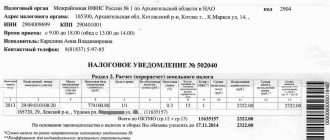Organizations
Let’s say right away that land tax can be included in expenses under the simplified tax system, income minus expenses in 2021. This type of expense, such as taxes and fees paid in accordance with Russian legislation, is included in the list of expenses allowed when applying the simplification (subclause 22, clause 1, article 346.16 of the Tax Code of the Russian Federation).
This tax can be included in the tax base when it is paid. That is, land tax is included in expenses under the simplified tax system, income minus expenses only when it is transferred to the budget (subclause 3, clause 2, article 346.17 of the Tax Code of the Russian Federation).
It should be noted that if an organization is building on a land plot, then the amount of tax accrued during the construction period must be included in the initial cost of the property. This approach must be applied until the construction is registered as part of fixed assets (paragraph 9, paragraph 3, article 346.16 of the Tax Code of the Russian Federation, paragraphs 8, 14 PBU 6/01).
The tax paid must be indicated in Section I of the book of income and expenses. Is land tax included in expenses under the simplified tax system: income minus expenses? Without a doubt, the same cannot be said when paying a single income tax. Companies that have chosen such an object of taxation do not take into account expenses in tax accounting (clause 3 of Article 346.21 of the Tax Code of the Russian Federation).
The procedure for calculating land tax
Land tax is calculated by multiplying the tax rate by the tax base, which is the cadastral value of the land. When calculating tax for the year, you should take the cadastral value established at the beginning of the tax period. A new procedure for calculating property taking into account its cadastral value was introduced in 2015.
If the taxpayer has challenged the cadastral value of his plot indicated in Rosreestr in court or in the cadastral commission and a positive decision has been made in the case, he has the right to recalculate the land tax for all periods up to the moment when the application for revision was submitted.
The regional government forms the tax rate (the size of which is directly dependent on the category of land) by issuing a corresponding law by the subject of the Federation. The limit value established in the Tax Code of the Russian Federation is the tax rate (in accordance with paragraph 1 of Article 394 of the Tax Code of the Russian Federation) in the amount of:
- 0.3% for agricultural land and for the maintenance of subsidiary farming, as well as for plots of housing and limited-use plots;
- 1.5% for other lands.
Taxpayers - legal entities pay land tax in advance payments (clause 2 of Article 396 of the Tax Code of the Russian Federation).
Read about the timing of advance payments in 2021 here.
Businessmen (IP)
As for entrepreneurs, when calculating the single tax, they can take into account the amount of land tax on plots intended for business activities (subclause 22, clause 1, article 346.16 of the Tax Code of the Russian Federation). In this case, the fact that the land plot is used for business activities does not matter. Thus, the land tax as expenses under the simplified tax system can take into account income minus expenses of an individual entrepreneur when calculating the tax base.
It is clear that an individual entrepreneur who uses a simplified income tax cannot take into account land tax (Article 346.15, paragraph 3 of Article 346.21, paragraph 6 of Article 346.25.1 of the Tax Code of the Russian Federation).
Read also
29.06.2016
General provisions on land tax under the simplified tax system
Based on Art.
388 of the Tax Code of the Russian Federation, the obligation to pay land tax arises for any person (legal and individual) if he owns a land plot (or in perpetual use or lifelong possession). In order to classify paid land tax as expenses when calculating income tax, personal income tax or under the simplified tax system with the object of taxation “income minus expenses”, it is important that the land plot is used for taxable commercial activity.
ATTENTION! Land tax is paid to the Federal Tax Service at the location of the land plot (Letter of the Ministry of Finance dated November 29, 2017 N 03-05-05-02/79165).
When the obligation to pay land tax arises and which areas are taxable, find out in the article “Object of taxation of land tax”.
Individual entrepreneur on the simplified tax system: notifications on land tax
If legal entities can independently calculate the amount of land tax, then individual entrepreneurs must wait for a special tax notification.
For your information! Previously, before 2014, both individuals and legal entities had to submit tax returns. But since 2015, individual entrepreneurs have been exempted from this obligation - now they receive tax notices with a pre-calculated amount of land tax.
It happens that the notification for some reason does not reach the addressee, then the taxpayer himself must appear at the tax authority and report the plot of land he owns. You must have all registration documents with you.
As the Tax Code states, representatives of the tax inspectorate must send notifications with the tax amount 30 days before the deadline for paying the land tax. From 2021, for individual entrepreneurs this deadline is December 1. This means that it will be necessary to take care of providing the tax authorities with the necessary information in the absence of notification in November.
Important! Starting from 2021, in cases where an individual entrepreneur-taxpayer who owns land has not received notification of the amount of land tax and has not voluntarily contacted the tax office in order to have the amount of tax payment calculated and assigned to him, he is obliged will incur administrative liability. In particular, he will be fined 20% of the unpaid tax and penalties.
In this article, we tried to talk about all the nuances of land tax relating to organizations and individual entrepreneurs who are on a simplified taxation system. However, to obtain more accurate information for each specific region of the Russian Federation, you should contact the tax office at the place of registration, since land tax rates, as well as the timing and procedure for its payment, are determined by the regions of the Russian Federation at the local level.
Land tax under the simplified tax system is paid by taxpayers on a general basis, as well as under the OSNO. The Tax Code does not provide for exemption from paying land tax under the simplified tax system (clause 2 of Article 346.11 of the Tax Code of the Russian Federation lists all cases of tax exemption for organizations working under the simplified tax system).
Legislation for legal entities
At the legislative level, the issue of paying the fee is regulated in the Tax Code. Not all entrepreneurs and heads of organizations know the intricacies of paying this type of fee. In order to understand the nuances of payment, you need to spend a little personal time.
You should pay attention to those points, the observance of which will allow you to carry out activities without hindrance. When paying, depositing a larger amount than was charged is considered ineffective; when depositing a smaller amount, this is fraught with consequences.
Land taxation for legal entities has common features with this type of quitrent for citizens, but it also has its own characteristics.
The first difference is that for individuals the fee is calculated by the competent authority and sent to the person in finished form. When the land owner trusts the calculation made by specialists, he can use the document sent for payment.
After receiving the notification, the citizen pays the rent in a way convenient for him. Currently, there is such an opportunity as online payment; this can be done using several sites.
Organizations must calculate the tax to pay themselves. Payment is made in accordance with the established payment regulations every year.
This situation can be viewed from both a positive and negative side. The advantages are that the entrepreneur is unlikely to make the calculation in such a way that he will have to pay extra.
However, the disadvantages are that an error may be made during the calculation and the amount calculated is less than what needs to be paid. In such a situation, when conducting an inspection by the competent authority, this violation is indicated in a categorical manner.
Features of establishing cadastral value
Land tax for individual entrepreneurs is calculated using the formula: cadastral value of the plot multiplied by the tax rate.
This is a simplified formula that does not take into account possible benefits and regional coefficients. Often, increasing coefficients are established for plots used for business purposes. The above calculation procedure applies only if the land plot was owned by the entrepreneur for the entire year. If the land was owned by the individual entrepreneur for an incomplete period, then the land tax is calculated depending on the number of full months of ownership of the plot. In this case, the month is considered complete if the ownership of the land was registered before the 15th day or ceased to be valid after the 15th day. In opposite cases, an incomplete month does not take part in calculating the taxable base.
The land tax fee for individual entrepreneurs for an incomplete year is calculated using the following formula: cadastral value as of the date of registration of the plot* tax rate/12*number of full months.
The cadastral value used for taxation purposes is established annually by decision of local governments. The results of the assessment are displayed in the state cadastre. You can find out the current cadastral value on the public cadastral map of Rosreestr by entering the cadastral number, or by requesting an extract from the Unified State Register from the regional office of the department.
In practice, there are often situations when the established cadastral value significantly exceeds the market value, which ultimately leads to an increase in the fiscal burden on the taxpayer.
In this case, entrepreneurs have the right to appeal the cadastral value of the land. In doing so, they must rely on Federal Law No. 135 and the position of the Supreme Court set out in Resolution 28, which contain legislative norms for appealing the cadastral value and application - amended.
This might also be useful:
Is the information useful? Tell your friends and colleagues
By clicking on the “Submit” button you confirm that your comment does not contain personal data in any combination.
Questions and answers in the comments are provided by site users and are not in the nature of legal advice. If you need legal advice, we recommend that you obtain it by calling the numbers listed above or using this form
The simplified taxation system was created specifically to make life easier for entrepreneurs, and not complicate it. In fact, often, everything happens exactly the opposite: a payer who has recently switched to the simplified tax system is lost and does not understand either how to calculate the single tax or how to reflect it in accounting. The result is a lot of errors, and the Internet is full of messages “help me calculate the simplified tax system.”
We have collected all the most common mistakes when calculating a single tax, read the questions and advice from regulars, and prepared a cheat sheet for you: how to correctly reflect the tax under the simplified tax system using transactions?
Payment of land tax on the simplified tax system if the land has been owned for less than a year
As with any other types of taxes, the calculation and payment of land tax has its own characteristics. In particular, taxpayers often have questions in cases where the right to use a plot of land arose within a year. How to calculate tax in such situations?
It’s simple: the cadastral value of the plot must be taken on the date when the cadastral registration took place. At the same time, the amount of tax must be calculated taking into account a special coefficient, which you need to calculate yourself. To do this, you need to look at how many full months of the year the land plot was owned. Then the resulting number must be divided by 12 - the result will be the desired coefficient.
5/12 (5 months: 12 months) Next we calculate:
6250 rub. – 2500 rub. = 3750 rubles - this is exactly how much money this enterprise must pay to the state budget as land tax.
Land tax rate
According to the law, the land tax rate is determined at the level of local authorities, depending on the characteristics of each specific region. The subject of the Russian Federation issues a corresponding law, which clearly defines the categories of land plots and the tax rate on them. However, at the federal level its limit values are defined:
- for agricultural land, subsidiary plots, and housing plots – 0.3%
- for other lands - 1.5%
Managers of enterprises and organizations should remember that legal entities must pay land tax in advance payments with the regularity established by law.
Privileges
Some categories of persons liable to pay taxes are provided with preferential conditions. Regarding citizens, it is provided that the amount of quitrent is significantly reduced if there is a benefit. At that time, the availability of benefits for a legal entity implies complete exemption from the obligation in question.
In this case, before starting to study the nuances of paying taxes, entrepreneurs need to refer to the list of types of institutions that, based on the principle of providing benefits, are exempt from tax. An entrepreneur can find his organization in this list and will not need to calculate and pay rent.
The following are exempt from payment:
- organizations carrying out religious activities;
- institutions specializing in the execution of punishments;
- those companies on whose territory there is a road intended for general purposes;
- institutions where persons recognized as disabled participate (provided that they constitute more than 8/10 of the total number of members);
- organizations involved in folk arts and crafts;
- institutions engaged in the repair and construction of ships (distributed in areas designated for this type of activity);
- in the regions of the Far North.
Tax payment procedure for individual entrepreneurs and organizations
Legal entities using the simplified tax system and individual entrepreneurs who use the simplified tax system pay tax in different ways. The reporting procedure for organizations and individual entrepreneurs using the simplified regime is also different.
Let's start with entrepreneurs. If you have registered an individual entrepreneur and own land, then you do not need to worry about calculating taxes and submitting documents. According to the changes that came into force on 01/01/15, entrepreneurs pay tax on the basis of a notification. The simplified procedure provides for the following conditions:
- You do not need to calculate the tax amount yourself. The fiscal service authority will send you a notification by mail, which will provide a full calculation of the payment amount;
- Along with the notification, a receipt is sent by mail, which contains all the necessary details for payment. All you need is to go to the nearest bank branch along with the receipt to transfer funds;
- For individual entrepreneurs, the obligation to file a tax return has been canceled, that is, there is no extra reason to visit the Federal Tax Service.
Individual entrepreneurs pay land taxes in the current year for the previous year (until December 31). The law stipulates that you must receive the notification no later than November 1 of the year (for 2021 - before 11/01/17).
The situation is a little more complicated with legal entities - “simplified”. They have a complete procedure for calculating tax, paying it and submitting reports.
Let's start with the documents: before February 1 of the next year, the “simplified” organization submits a declaration in which it indicates the full calculation of the tax in accordance with the established norm. You can submit your declaration in the way that is most convenient for you:
- Personal visit to the Federal Tax Service (receiving a form and filling out the form on the spot);
- Russian postal services (sending a letter with a notification and a list of attachments);
- Transfer of papers through a representative (you must first contact a notary to draw up a power of attorney);
- Using the electronic resource of the Federal Tax Service (the website of the fiscal service offers users the service of filing reports via the Internet).
By filing your return on time, ensure that your tax is paid on time. The law regulates the advance payment system for land taxes. Payments are made quarterly, their amount is determined as ¼ of the annual one. The payment deadline for each amount is until the end of the month following the quarter. Full payment of land tax must be made no later than October 1 (until 10/01/17 for 2016).
Example No. 3.
The accountant of Fontan LLC calculated the amount of land tax for 2016 in the amount of 2,104 rubles. Quarterly payments were:
RUB 2,104 / 4 sq. = 526 rub.
When submitting a declaration at the end of the year, the Fontana accountant indicated the annual amount of 2,205 rubles. (including recalculation). The final calculation of the land tax was made by Fountain on January 10, 2017. The last payment amount was calculated as follows:
RUB 2,205 – (526 rub. * 4 sq.) = 101 rub.
Tax amount
There is a simple formula to calculate the contribution payable:
Land tax = tax rate adopted in the region * cadastral value of the plot.
The cadastral price is updated on the 1st day of the reporting year (the one for which the tax must be paid).
For example, the cadastral value is 578,000 rubles. The tax payable at a rate of 0.3% will be; 578000*0.3% = 1734 rubles. If a rate of 1.5% is applied, then the tax will be equal to: 578,000 * 1.5% = 8,670 rubles.
The cadastral value and the applicable tax rate will be indicated on the payment receipt. If you have payment benefits, they must be recorded with the tax office. To do this, you will need to collect a package of documentation confirming the availability of benefits and provide it to the operator for further accounting.
Who doesn't pay tax
In addition to the current benefits for the population, there is also the possibility of complete exemption from paying contributions.
This rule applies throughout the Russian Federation and applies to areas:
- Managed by the forest fund;
- Seized as a result of a decision of local authorities (for example, for the purposes of a nature reserve or the disposal of radioactive waste);
- Limited in use (occupied by cultural heritage or natural water bodies);
- Used for highways;
- Being the common property of an apartment building;
- Available for free use;
- Rented (in this case the owner of the plot pays the tax);
- Inhabited by small numbers of indigenous people (if the plot is used for living and conducting their own fishing).
The owner has the opportunity to reduce the value of the tax base. This is due to the cadastral value, which may not always be adequate.
If you think that the price of your plot is too high (and the higher it is, the higher the tax to be paid), you need to invite an independent appraiser who, based on experience and knowledge, will draw up a document on the real value of the property.
With the received certificate, you need to contact the commission for the consideration of such disputes. If the issue is not resolved in your favor pre-trial, then it is necessary to file a statement of claim.
New bans on tax exemptions
New paragraph 2 of Art. 395 of the Tax Code of the Russian Federation, which was introduced by Law No. 353-FZ of November 27, 2017, regulates the situation when, when dividing or merging land plots, tax exemption is not applicable to the resulting objects. This applies only to the following categories of payers:
- residents of a special economic zone (there will be no tax exemption for the first 5 years);
- shipbuilding enterprises are residents of the industrial and production SEZ (there will be no tax exemption for the first 10 years);
- participants of the free economic zone (there will be no tax exemption for the first 3 years).
We calculate and pay taxes
You have calculated the tax base for a certain period of time. What's next?
Next, we calculate the amount of EUR to be paid to the budget (line 110 of the declaration). To do this, we multiply the base by the corresponding tax rate and subtract the amount of tax contributions already paid from the resulting value. The resulting amount is a tax or advance payment, which you need to reflect in accounting for accrual or payment in an accounting program, for example 1C.
If you have a 1C version younger than 8.3.0.31.11, you will have to enter transactions for the single tax simplified tax system manually or use semi-automatic filling. For semi-automatic filling you need:
- Go to the main page of the program;
- Enter the section “Correspondence of invoices”;
- To calculate tax, select account “99” in the drop-down list for debit, and subaccount “12” for credit “68”.
- In the “Documents” column we find the hyperlink “Operation BU and NU” and follow it. Fill in the empty fields and indicate the amount.
- We press Enter and we can see the completed operation in the log.
In the same way, the posting for the payment of EN with the correspondence of accounts “Dt 68.12 Kt.51” is carried out, and we indicate the document - “write-off from the account” on the “Bank and Cash Office” tab. By the way, in later versions of 1C, the calculation and payment of tax according to the simplified tax system are fully automated.
>Recording of land plots under “simplified”
O.E. Shpilevaya, D.V.
Certain cases of tax payment
Let's consider non-standard situations of paying land taxes. The first such case is taking into account the mandatory contribution for joint ownership of a plot. If there are several owners of one plot, then they pay land tax in proportion to their share.
Example. You own a plot of 75 square meters. Your plot is part of one large plot of 238 square meters. The total cadastral value of the land is equal to 300,000 rubles. Since the plot is used for breeding livestock for sale, the tax rate is 0.3%. First you need to calculate the cadastral value of 75 square meters. It is equal to: 300,000*75/238 = 94,538 rubles. The tax amount will be: 94538*0.3% = 283 rubles.
It is important to understand that if you are the owner of the participant jointly with the state authorities, you will pay tax on the entire plot. Even if you only use a small plot, the fee will be charged on all square meters.
This is due to the peculiarities of state ownership of land. Local authorities are limited in the ways they can dispose of land, and therefore are exempt from paying taxes.
Let's consider the second case, when the plot was in your ownership for an incomplete number of years.
Example. The plot was purchased on May 23, 2021. On January 1, 2021, the cadastral value was 652,000 rubles. The region has a rate of 0.3%. For tax purposes, only the months from June to December are accepted, since the property was purchased in the second half of May. We get the amount of tax to be paid: 652000*0.3%/12*7 = 1141 rubles.
There are also situations in which, when paying land tax, both benefits and an incomplete number of months of use of the site are taken into account.
Example. A disabled person of the 1st group registered an individual entrepreneur in August 2021. For business purposes, a citizen acquired a plot of land on November 19, 2021. The cadastral value of the land is equal to 523,000 rubles. The local administration has established a tax rate for this plot of 0.9%. To calculate the tax required to be paid in 2021, it is necessary to calculate the tax base. It will be (taking into account the benefit of 10,000 rubles for a disabled person of the 1st group): 523,000 - 10,000 = 513,000 rubles. The plot was owned for 1 full month. The tax amount will be: 513000*0.9%/12*1 = 385 rubles.
What do you need to know about the single tax?
Entrepreneurs who apply the “simplified tax” pay one instead of three main taxes (profit, property and value added):
- or 6% of total income for 12 months;
- or 15% of the difference between income and expenses, but not less than 1% of total income.
The percentage charged under the “income” taxation scheme is unchanged. But for legal entities and individual entrepreneurs who have determined the “income-expenses” scheme as the basis, regional laws may establish a reduced tariff.
Also from 01/01/15. for individual entrepreneurs who carry out business activities in the following areas:
- education,
- the science,
- production,
For two years in a row, a zero (0%) single tax tariff is established if the individual entrepreneur meets the following requirements:
- 70% of income from economic activities relates to income in one of the areas indicated above;
- The individual entrepreneur complies with the requirements of regional law in terms of the average number of employees and the amount of total income received.
For tax purposes, all incoming and expended funds from the business or other activities of a legal entity or individual entrepreneur must be reflected in the KUDiR.
Next, on the basis of the formed KUDiR, from the beginning of the year until the end of the corresponding payment period, either the amount of income or the difference between income and expenses is calculated.
Advance periods for the Unified Tax Code on the simplified tax system are 3,6 and 9 months, while the tax period is considered to be one calendar year. Accordingly, the single tax must be calculated and paid four times a year - at the end of each quarter and within 3 months after the end of the tax period. The transfer of tax for the entire period is carried out simultaneously with the submission of a tax return, which reflects the amounts of payments already made and the remaining amount of debt.
Remember that from 01/01/2013 all entrepreneurs on the simplified tax system are required to maintain not only KUDiR, but also organize full-fledged accounting, as well as generate accounting and tax reporting. Accordingly, your task, as a payer, is not only to calculate and transfer tax to the budget, but also to correctly calculate and write it off using accounting entries.
Property tax in case of registration in 2018
When renting out non-residential (residential) premises, the owner of this premises and the tenant are parties to a civil law agreement - a rental agreement for premises concluded in accordance with Chapter. 34 Civil Code of the Russian Federation. Subjects of civil law, that is, participants in relations regulated by civil law, are citizens (individuals) and legal entities, as well as property owned by them. At the same time, individuals engaged in entrepreneurial activities and who have passed state registration have the right to carry out those types of activities that are indicated in the Unified State Register of Individual Entrepreneurs (USRIP). There are several options:
- check the value indicated in the cadastral passport;
- contact the FSGRKK (State Cadastre);
- use the electronic resource of Rosreestr.
The last option is the most convenient, as it allows you to find out the cadastral value of the plot without leaving your home. To obtain information, you need to know the cadastral number of the plot. It is also possible to search by the address of the site. Tax rate Since the land tax is regional, it is the municipal authorities who determine at what rate the amount of payment to the budget must be calculated. At the same time, at the federal level, maximum indicators are fixed, above which the tax rate cannot be set. The main indicator is set at 1.5%.
Payment benefits
The state has created benefits for paying taxes on land plots for certain categories of citizens. Exemption from contributions is carried out on a full or partial basis.
The tax base for the following persons is reduced in the amount of 10,000 rubles:
- Disabled people of groups 1 and 2;
- Disabled since childhood;
- Heroes of the USSR or the Russian Federation;
- WWII veterans;
- Participants in man-made disasters and persons taking part in their liquidation (persons exposed to radiation).
For these categories, 10,000 rubles are deducted from the tax base. Also, each region can establish additional benefits. For example, in some areas there is a regulation establishing the area of the plot that is not subject to tax.
If the plot is larger than this area, then only a contribution is paid for the difference between the actual size and that established by law. For those whose plot is less than or equal to the area specified in the legal document, the tax is equal to zero.
If you are the owner of several plots in different regions, then you are entitled to benefits for each individual plot. If you own lands within one subject of the Russian Federation, then you can use only one of them for preferential tax purposes.
Payment deadlines
The terms regarding payment are determined for the previous year. The form in which payment will be made and the period for its production are to be determined in each region separately.
An example of calculating the amount of advance payment for land tax
These provisions are established by regional authorities in the form of an order and may consist of parts that are divided into quarters, additional advance payments, as well as full payment of the tax made at a time.
In this regard, we can say that entrepreneurs need to independently find out the deadlines for making payments and submitting reports at the local level.
How to pay property tax with a tax system in 2017-2018?
In most cases, “simplified” people who own a plot of land and use it for a retail outlet, warehouse, production, office, etc., calculate the tax based on this value. In rare cases, tax may be paid at a reduced rate of 0.3%. You have the right to use this indicator for calculation if you use the land for agricultural purposes, as well as for gardening, vegetable farming, livestock farming (for example, you grow crops for sale).
Rates may be reduced at the discretion of local authorities. In order to clarify what rate applies to a particular plot in your region, we advise you to contact the Federal Tax Service at your place of residence (registration).
Deadlines and procedure for submitting reports and paying land tax
The frequency and timing of payment of land tax are established by regional laws, which are adopted by municipal authorities (clauses 1 and 2 of Article 397 of the Tax Code of the Russian Federation). And in paragraph 9 of Art. 396 of the Tax Code of the Russian Federation states that the municipal legislative body may even cancel the quarterly payment of advances for certain categories of taxpayers.
In Art. 397 of the Tax Code of the Russian Federation defines deadlines for paying taxes and submitting reports. The deadline for filing a tax return is February 1. As for the tax itself, legal entities cannot pay it before this deadline. You can find out more about the deadlines for paying land tax in your region on the official website of the Federal Tax Service.
IMPORTANT! From 2021, land tax for legal entities will be calculated by tax authorities based on the information they have received from the Roskadastre service. If a legal entity has a benefit, it is obliged to notify the Federal Tax Service about this. If a company has a plot of land, but has not received a notification about the tax, from 01/01/2021 it is obliged to notify the Federal Tax Service about the available land. If the message is not sent on time, tax authorities will issue a fine of 20% of the tax amount. For details, see the material “Organizations will have to report transport and land plots to the tax authorities.”
Starting from 2021, individual taxpayers must pay the local budget by December 1 of the year following the reporting year (Law No. 320-FZ dated November 23, 2015 “On Amendments to the Tax Code of the Russian Federation”).
IMPORTANT! From 01/01/2021, a single deadline for payment of land tax and advances on it for legal entities is established throughout the Russian Federation - March 1 of the year following the reporting year for payment of the annual tax, and the last day of the month following the reporting quarter for the transfer of advances. See here for details.








